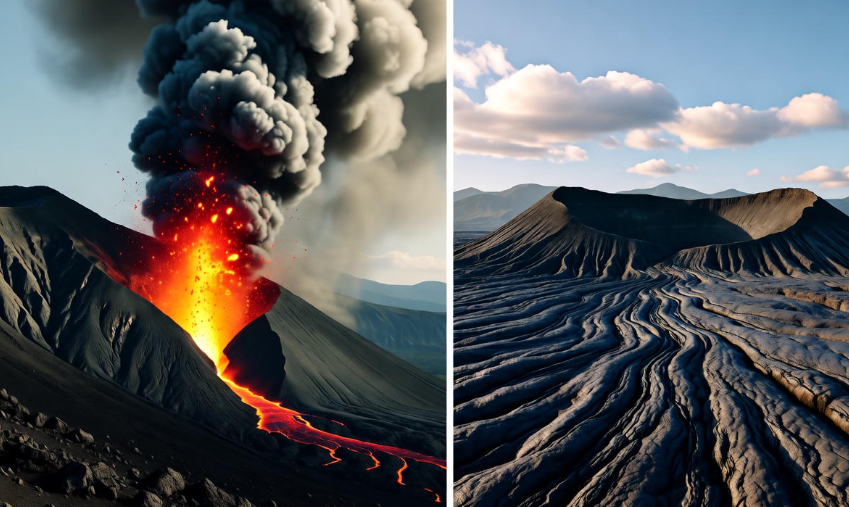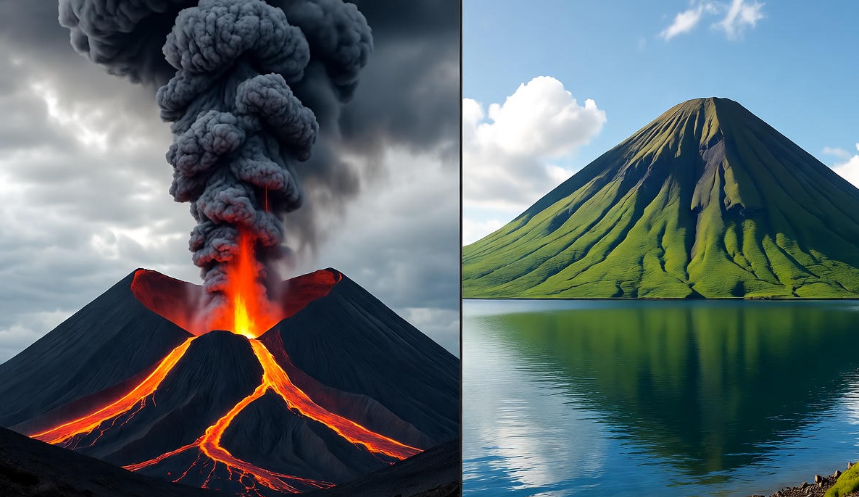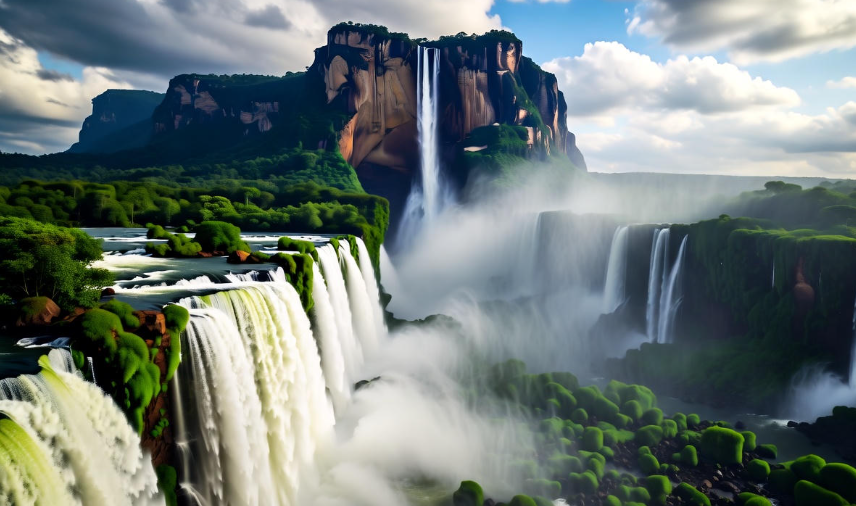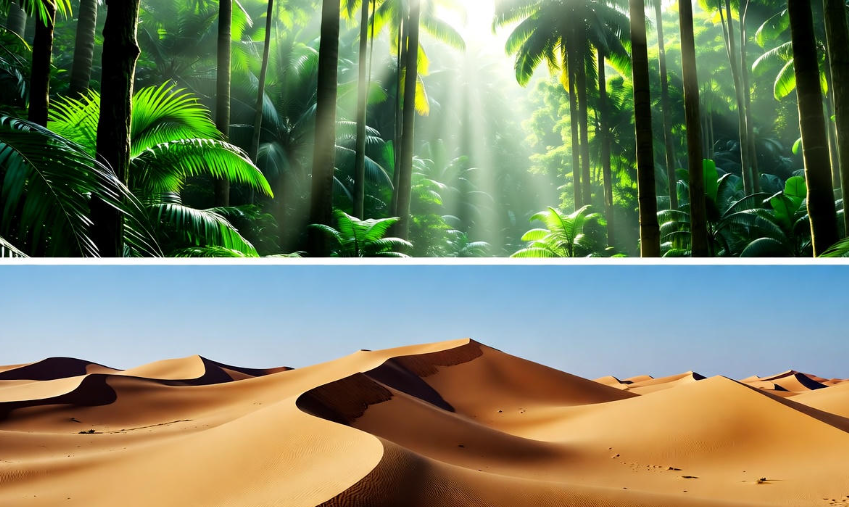Have you ever wondered how our planet keeps changing — mountains growing, islands appearing, or coastlines shifting? One of the most amazing natural ways this happens is through volcanoes. Yes, those fiery mountains that spit out lava and ash can actually build new land. It might sound scary, but volcanoes play a huge role in shaping Earth’s surface — and even creating places where life can thrive.
Let’s go step by step and understand how volcanoes slowly create new land over time.
What Exactly Is a Volcano?
A volcano is like a natural vent or hole in the Earth’s crust. Deep inside the planet, there’s something called magma — a super hot, melted rock that moves around. When pressure builds up underground, magma pushes its way out through cracks. Once it reaches the surface, it becomes lava.
When that lava cools down, it hardens into solid rock. Over time, layer after layer of cooled lava can form new land — sometimes entire islands or even mountain ranges.
Here’s a simple look at what happens:
| Stage | What Happens | Result |
|---|---|---|
| 1️⃣ | Magma rises due to pressure | Cracks form in the crust |
| 2️⃣ | Lava erupts and flows out | Surface gets covered by molten rock |
| 3️⃣ | Lava cools down and solidifies | New layer of rock forms |
| 4️⃣ | Repeated eruptions occur | Land grows higher and wider |
How Volcanoes Build New Land
When a volcano erupts, it might seem destructive — and yes, it can be. But each eruption also adds something new to Earth’s surface. The lava, ash, and rocks that come out settle around the volcano. Over many years (sometimes thousands), this builds up into new land.
For example:
-
In Hawaii, most of the islands were formed from volcanoes under the ocean.
-
The Icelandic landscape is mostly made of volcanic rock — even the beaches have black sand because of cooled lava!
-
Small volcanic eruptions in the ocean have created tiny islands that later grow larger as more lava adds layers.
So even though volcanoes can destroy, they also create.
Volcanoes Under the Sea (Seamounts and Islands)
Most volcanic activity actually happens under the ocean. There are thousands of undersea volcanoes, called seamounts. Some of these grow tall enough to reach above the ocean’s surface, becoming new islands.
Here’s what typically happens:
-
Magma erupts underwater.
-
The lava cools down faster (because of the water) and builds up layers.
-
Over many eruptions, the mountain grows taller.
-
Eventually, it breaks the surface — and boom, a new island appears!
A real-life example is Surtsey, a small island near Iceland that appeared in 1963. It formed from an underwater eruption and grew to about 2.7 square kilometers. That’s brand-new land — made in our lifetime!
The Role of Lava Types in Land Formation
Not all lava behaves the same way. The type of lava affects how new land forms.
| Lava Type | Flow Speed | Appearance | Result |
|---|---|---|---|
| Pahoehoe Lava | Smooth and fast | Rope-like surface | Creates broad, smooth land |
| Aa Lava | Thick and slow | Rough, jagged surface | Builds uneven rocky ground |
| Pillow Lava | Forms underwater | Rounded shapes | Builds underwater mounds |
So, the texture of new volcanic land depends on which type of lava came out during eruptions. Cool, right?
How Long Does It Take to Make New Land?
It can happen both instantly and slowly. Some islands can appear within days or weeks after a powerful eruption. But usually, land formation is a long, slow process — it takes hundreds or thousands of years for lava layers to pile up, cool, and become stable land where plants and animals can live.
For example:
-
Hawaii took millions of years to grow into the island chain we see today.
-
Krakatoa, in Indonesia, erupted in 1883 and destroyed much of itself. But by 1927, a new island called Anak Krakatau (“Child of Krakatoa”) began forming in the same spot!
How Life Begins on New Volcanic Land
When new land is created by lava, it starts as plain, hard rock — not exactly a friendly place for life. But over time, nature takes over.
Here’s how life slowly appears:
-
Weathering – Rain, wind, and waves break the rocks into smaller pieces.
-
Soil formation – Dust, minerals, and organic matter build up into thin soil.
-
Pioneer species – Tiny plants, mosses, and lichens start growing.
-
Ecosystem growth – Larger plants and animals follow once there’s enough soil.
So, what began as fiery lava eventually becomes a green, living world.
Volcanoes: The Earth’s Natural Builders
Even though volcanoes can seem dangerous, they’re also essential for Earth’s renewal. Without them, our planet’s surface might look completely different — maybe flatter, less colorful, and without some of the world’s most beautiful islands.
They recycle materials from deep within the Earth, release gases that shape the atmosphere, and create the very land we live on.
So next time you see a picture of a volcano, remember — that “destructive” force might be building the next island humans will one day call home. ️
Fun Facts About Volcano Land Formation
| Fact | Description |
|---|---|
| The word “volcano” comes from “Vulcan,” the Roman god of fire. | |
| Some volcanic rocks are light enough to float on water! | |
| About 80% of Earth’s surface (above and below the sea) is made of volcanic rock. | |
| ️ The hottest lava can reach over 1,200°C (2,200°F). | |
| Volcanoes on other planets, like Mars, are much bigger — Olympus Mons is the largest volcano in the Solar System. |
Why Volcanic Land Is So Fertile
Once volcanic ash and rock break down, they form very rich soil. This is why you’ll often find farming near old volcanoes — crops grow really well there!
The ash contains minerals like iron, potassium, and phosphorus, which help plants grow strong and healthy. That’s why volcanic areas in places like Indonesia, Italy, and Hawaii are full of green farms and forests.
Are Volcanoes Still Making New Land Today?
Yes, all the time!
New land is being made even as you read this. Underwater volcanoes in the Pacific Ocean are constantly erupting, adding new layers to the seafloor. Some of these might rise to form the next island chain thousands of years from now.
Recent examples include:
-
La Palma (Canary Islands, 2021) – Created new coastal land as lava met the ocean.
-
Hunga Tonga–Hunga Ha’apai (Tonga, 2015) – Formed a new island that later merged with nearby ones.
So the Earth never stops changing — it’s always growing, reshaping, and renewing itself.

The Cycle of Destruction and Creation
Volcanoes remind us that destruction and creation often go hand in hand. A single eruption can destroy villages, yet a few decades later, that same area can become fertile farmland or even a lush island.
It’s a reminder that nature works in cycles. Out of fire and chaos, new life and land are born.
Quick Summary Table
| Process | Description | Result |
|---|---|---|
| Eruption | Magma escapes through the crust | Lava spreads on the surface |
| Cooling | Lava cools into solid rock | New rocky land appears |
| Repetition | More eruptions add layers | Land expands or rises |
| Colonization | Plants and animals move in | Ecosystem develops |
FAQs About Volcanoes and Land Formation
Q1. Can a volcano really make a whole island?
Yes! Many islands, like Hawaii and Iceland, were formed entirely by volcanic eruptions over millions of years.
Q2. How long does it take for volcanic land to become fertile?
It depends, but usually within a few decades, plants start growing once the rock breaks into soil.
Q3. Are underwater volcanoes dangerous?
Most are deep underwater and harmless to us, but some can cause tsunamis if they erupt near the surface.
Q4. Can humans live on volcanic land?
Yes, millions of people live on volcanic land because it’s fertile and good for farming — though it comes with some risks.
Q5. Do volcanoes still form new land today?
Absolutely! New islands and lava fields are still forming in places like Hawaii, Iceland, and Tonga.
Final Thoughts
Volcanoes are nature’s artists — sculpting, building, and transforming the world we live in. Even though they can be powerful and unpredictable, they’re also the reason we have new lands, fertile soil, and stunning landscapes.
So, next time you see the fiery glow of a volcano on TV or in a picture, think of it not as destruction, but as the beginning of something new — maybe even the start of a whole new world.




